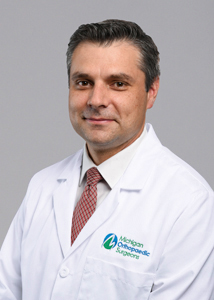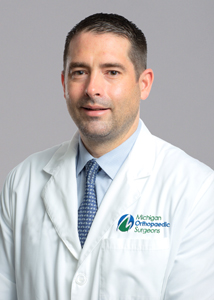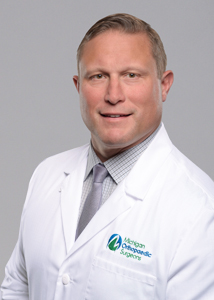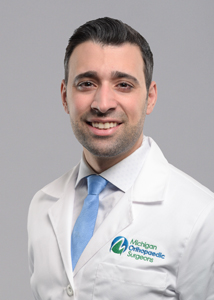Your knees need the largest orthopaedic team in Michigan.
The knee is the largest joint in the entire body – giving you the strength you need to run, jump and do what you love. But with a limited range of motion and almost no ability to rotate, it’s thought to be more susceptible to injury. And… that’s where we come in. The experts at Michigan Orthopaedic Surgeons perform thousands of total knee replacements every year, along with 13 other specialized surgeries. Considered the most comprehensive orthopaedic group in the state, we work together to restore normal, natural movement… now.
Conditions
Anterior Cruciate Ligament (ACL) Injury
Cause
An ACL tear or sprain is one of the most common knee injuries. There are several ways the ACL can be injured, including:
- Changing direction rapidly
- Stopping suddenly
- Slowing down while running
- Landing incorrectly after a jump
- Direct contact or a collision, such as a football tackle
About half of all injuries to the ACL occur in addition to damage to other structures in the knee, such as articular cartilage, the meniscus and/or other ligaments.
Grades
Injuries to the ligaments are called sprains and are graded on a scale of 1-3 of severity. The grades are as follows:
- Grade 1: The ligament is mildly damaged. It has been slightly stretched, but it’s still able to help keep the knee joint stable.
- Grade 2: The ligament is stretched to the point where it becomes loose. This is often referred to as a partial ligament tear.
- Grade 3: This is a complete tear, in which the ligament has been split into two pieces and the knee joint is unstable.
Most ACL injuries are complete or nearly complete tears. Partial ACL tears are rare, but they do occur.
Who’s Likely to Get It
ACL injuries are more common among athletes who compete in high-demand sports, such as football, soccer or basketball. Several studies have shown that, in certain sports, female athletes have a higher incidence than male athletes, which may be due to differences in physical conditioning, muscular strength and neuromuscular control. Other suggested causes include differences in pelvis and lower extremity (leg) alignment, increased looseness in ligaments and the effects of estrogen on ligament properties.
Symptoms
When you injure your anterior cruciate ligament, you may hear a “popping” noise and feel the knee give out. Other symptoms include:
- Pain and swelling – Within 24 hours, the knee will swell, and that swelling may or may not resolve itself. When returning to an activity or sport, the knee will likely be unstable, causing further risk of damage to the cushioning cartilage (meniscus) in the knee.
- Loss of full range of motion
- Tenderness along the joint line
- Discomfort while walking
Treatments
Treatment depends on the severity of the injury and the age of the patient. For example, a young athlete who experiences a tear while competing in sports may require surgery, while an older patient who experiences an ACL injury won’t necessarily require surgery if they are returning to a more sedentary (less demanding) physical lifestyle.
Regardless, a torn ACL will not heal without surgery. Nonsurgical treatment may benefit patients who are older or have a low activity level. Options include:
- Bracing: A doctor may recommend a brace to protect the knee from instability.
- Physical therapy: As the swelling goes down, a rehabilitation program is initiated. Specific exercises will restore function to the knee and strengthen the leg muscles that support it.
To surgically repair the ACL and restore knee stability, the ligament must be reconstructed. A doctor will replace the torn ligament with a tissue graft, creating a scaffolding of sorts for the new ligament to grow. (Grafts can be obtained from several sources, like the patellar tendon, which runs between the kneecap and the shinbone. Hamstring tendons at the back of the thigh are another common source of grafts, as well as the quadricep tendon – running from the kneecap into the thigh. A cadaver graft can also be used.)
Cartilage Injuries
Collateral Ligament Injury (MCL and LCL)
Cause
Your knee ligaments – the medial collateral ligament (MCL) and lateral collateral ligament (LCL) – connect the thigh bone to your lower leg bones. A medial collateral ligament tear often occurs as a result of a direct blow to the outside of the knee, in which the knee is pushed inward (toward the other knee). A blow to the inside of the knee that pushes the knee outward may injure the lateral collateral ligament.
The MCL is injured more often than the LCL. And due to the more complex anatomy of the outside of the knee, a patient who injures the LCL often injures other structures in the joint as well.
Grades
Injuries to the ligaments are called sprains and are graded on a scale of 1-3 of severity. The grades are as follows:
- Grade 1: The ligament is mildly damaged. It has been slightly stretched, but it’s still able to help keep the knee joint stable.
- Grade 2: The ligament is stretched to the point where it becomes loose. This is often referred to as a partial ligament tear.
- Grade 3: This is a complete tear, in which the ligament has been split into two pieces and the knee joint is unstable.
Who’s Likely to Get It
Athletes who play contact sports, such as soccer or football, are more likely to injure the collateral ligaments.
Symptoms
Symptoms of a collateral ligament injury include:
- Pain at the sides of your knee (If there is an MCL injury, the pain is on the inside of the knee. An LCL injury may cause pain on the outside of the knee.)
- Swelling at the location of the injury
- The uncertain feeling that the knee will give out at any time
Treatment
Injuries to your MCL rarely require surgery, and an LCL injury requires treatment that’s similar to an MCL sprain. However, if the LCL injury involves other structures in the knee, treatment will be required to address those problems, as well.
Nonsurgical options include:
- Ice: Apply crushed ice to the injured area for 15 to 20 minutes at a time, with one hour between icing sessions.
- Bracing: A doctor may recommend a brace to protect the injured ligaments from additional stress and strain.
- Physical therapy: A doctor may recommend specific exercises designed to restore function to the knee and strengthen the leg muscles that support it.
Most isolated collateral ligament injuries can be successfully treated without surgery. However, if the collateral ligament is torn in such a way that it cannot heal or is associated with other ligament injuries, a doctor may recommend surgery to repair it.
Knee Arthritis
Meniscal Deficiency
Meniscus Tear
Cause
The meniscus can tear in different ways – all noted by how they look and where the tear occurs. Common tears include the bucket handle, flap and radial tears.
Who’s Likely to Get It
Meniscus tears are among the most common knee injuries in athletes. Those who play contact sports are at a higher risk for meniscus tears. However, anyone, at any age, can tear a meniscus. For example, cartilage weakens and thins over time. As a result, older people are more likely to have degenerative meniscus tears.
Symptoms
A patient may feel and hear a “pop” when their meniscus tears, but many people are still able to walk/keep playing on their injured knee. Over the course of two to three days, the knee will gradually become stiffer and more swollen.
The most common symptoms associated with a meniscus tear are:
- Pain, stiffness and swelling
- Catching or locking knee
- The sensation that the knee will “give out”
- Limited range of motion
Treatments
How a doctor treats a meniscus tear will depend on the type of tear you have, the size and specific location of the tear.
If your tear is small and on the outer edge of the meniscus, it may not require surgical repair. As long as your symptoms do not persist and your knee remains stable, nonsurgical treatment may be all that’s required – starting with the RICE protocol:
- Rest: Patient should refrain from participating in demanding physical activities, particularly the activity that caused the injury.
- Ice: Use cold packs of crushed ice for 15 to 20 minutes at a time, several times a day, with at least one hour between icing sessions.
- Compression: To prevent additional swelling and blood loss, wear an elastic compression bandage. Consult a doctor to ensure you’re doing it safely and correctly.
- Elevation: To reduce swelling, recline when resting – elevating your injured leg above the level of the heart.
Additionally, ibuprofen and aspirin may be used to reduce pain and swelling.
If symptoms continue after nonsurgical treatment, consult a doctor. They may recommend a knee arthroscopy – a commonly performed surgical procedure in which a miniature camera is inserted through a small incision to explore the injury internally. This provides a clear view of the inside of the knee and allows the surgeon to insert small surgical instruments to trim or repair the tear in a minimally invasive way.
Osteoporosis
Posterior Cruciate Ligament (PCL) Injury
Cause
The posterior cruciate ligament is located in the back of the knee, and it’s one of several ligaments that connect the femur (thighbone) to the tibia (shinbone). It also keeps the tibia from pivoting too far backward. An injury to it requires a powerful force, so common causes include a bent knee impacting the dashboard in a car accident and a football player falling with the force of their body weight on a bent knee. Injuries to the posterior cruciate ligament are not as common as other knee ligament-related injuries, and they’re often more subtle and thus more difficult to evaluate. Many times, a PCL injury occurs along with damage to other structures in the knee, such as cartilage, other ligaments and bone.
Grades
Injuries to the ligaments are called sprains and are graded on a scale of 1-3 of severity. The grades are as follows:
- Grade 1: The ligament is mildly damaged. It has been slightly stretched, but it’s still able to help keep the knee joint stable.
- Grade 2: The ligament is stretched to the point where it becomes loose. This is often referred to as a partial ligament tear.
- Grade 3: This is a complete tear, in which the ligament has been split into two pieces and the knee joint is unstable.
Symptoms
The typical symptoms of a posterior cruciate ligament injury are:
- Pain with associated swelling that occurs steadily and quickly after the injury
- Swelling that makes the knee stiff and may cause the patient to limp
- Difficulty with mobility and walking
- The sensation that the knee will “give out”
Treatments
If you injure just your posterior cruciate ligament, your injury may heal without surgery. A doctor may recommend simple options, including the RICE protocol:
- Rest: Patient should refrain from participating in demanding physical activities, particularly the activity that caused the injury.
- Ice: Use cold packs of crushed ice for 15 to 20 minutes at a time, several times a day, with at least one hour between icing sessions.
- Compression: To prevent additional swelling and blood loss, wear an elastic compression bandage. Consult a doctor to ensure you’re doing it safely and correctly.
- Elevation: To reduce swelling, recline when resting – elevating your injured leg above the level of the heart.
Your doctor may also recommend a brace to prevent your knee from moving and/or physical therapy. Typically, as the swelling goes down, a careful rehabilitation program is started. Specific exercises will restore function to your knee and strengthen the leg muscles that support it. Strengthening the muscles in the front of your thigh (quadriceps) has been shown to be a key factor in a successful recovery.
A doctor may recommend surgery if you have combined injuries. A torn posterior cruciate ligament typically has to be rebuilt. It will be replaced with a tissue graft that’s been taken from another part of the body, or from another human donor.
Treatments
Experts at Michigan Orthopaedic Surgeons offer the following treatment options:
- ACL Reconstruction Surgery
- Bilateral Knee Replacement
- Cartilage Injury Treatment
- Computer-Assisted Orthopaedic Surgery
- Computer-Assisted Total Knee Arthroplasty
- Lateral Collateral Ligament (LCL) Repair/Reconstruction
- Meniscus Tear Surgery
- Meniscus Transplant Surgery
- Minimally Invasive Knee Surgery
- Non-Operative Treatment
- Posterior Cruciate Ligament (PCL) Reconstruction
- Revision Knee Surgery
- Total Knee Replacement
- Partial Knee Replacement
Doctors








Peter Donaldson MD
Elbow, Foot and Ankle, Hip, Knee, Nonsurgical Orthopaedics, Shoulder, Sports Medicine









